Strengthen Coordination: Balance Training Benefits Explained
The Importance of Balance Training for Seniors: Techniques and Benefits
Seniors must maintain balance as they age. Falls can cause serious injuries and reduce independence. Balance training lowers fall risks and enhances quality of life. This post discusses techniques, benefits, and advice for seniors.
Why Balance Matters for Seniors
Balance influences daily activities. Simple actions like walking or turning may become hazardous. The CDC reports that one in four older adults falls yearly. These falls can result in fractures, head injuries, or death. Therefore, seniors must prioritize balance.
Good balance boosts self-confidence. Stable seniors engage more in activities they love. Such engagement improves both mental and physical health. Thus, balance training should feature prominently in seniors’ fitness routines.
Techniques for Balance Training
Seniors can use various balance training techniques. Here are some effective methods:
1. Standing on One Leg
This exercise enhances stability. Stand next to a wall or chair for support. Lift one leg, holding for 10 to 30 seconds. Switch legs and repeat. Aim for three sets on each leg. Gradually reduce support reliance.
2. Heel-to-Toe Walk
This technique improves coordination. Find a straight path and place one foot in front of the other. Walk straight, focusing on balance. Use a wall or railing if needed. Practice for several minutes daily.
3. Tai Chi
Tai Chi combines slow, controlled movements. It enhances balance, flexibility, and strength. Many community centers offer classes for seniors. Participating fosters social interaction and boosts mental health.
4. Balance Exercises with Props
Using props diversifies balance training. Stand on a balance pad or use a stability ball. These tools engage stabilizing muscles and challenge the body. Incorporate these exercises two to three times weekly for optimal results.
Tips for Safe Balance Training
Consider these tips when starting a balance training program:
1. Consult a Doctor
Consult a healthcare professional before starting any exercise regimen. They can offer guidance based on individual health conditions. This ensures safety and effectiveness.
2. Start Slow
Avoid rushing into complex exercises. Begin with foundational movements. Gradually increase intensity as confidence grows. This approach minimizes injury risk.
3. Stay Consistent
Consistency is crucial in balance training. Practice exercises at least three times weekly. Regular training leads to noticeable improvements. Keep a progress log for motivation.
Benefits of Balance Training
Balance training provides numerous benefits for seniors. These advantages extend beyond physical stability:
1. Reduces Fall Risk
Balance training primarily prevents falls. Improved balance enhances daily activity stability. Consequently, falling likelihood decreases significantly.
2. Enhances Mobility
Better balance allows smoother movement. Seniors navigate homes and communities more easily. Increased mobility fosters independence and encourages outdoor activities.
3. Boosts Confidence
Improved balance increases self-assurance. Stable seniors engage more in social events. This participation leads to a fulfilling lifestyle.
4. Improves Overall Health
Regular exercise, including balance training, boosts cardiovascular health and muscle strength. Active seniors experience higher energy levels and better overall health. Staying active also improves mental health, reducing isolation and depression.
Conclusion
Balance training is vital for seniors. It reduces fall risks, enhances mobility, and boosts confidence. Incorporate techniques like standing on one leg, heel-to-toe walking, Tai Chi, and using props to improve stability. Always consult a doctor, start slow, and remain consistent. The benefits of balance training promote an active, independent lifestyle. Prioritize balance training today for a safer, healthier tomorrow.
Below are related products based on this post:
FAQ
Why is balance training important for seniors?
Balance training is crucial for seniors as it significantly reduces the risk of falls, which can lead to serious injuries or loss of independence. Improved balance enhances daily activities and boosts self-confidence, allowing seniors to engage more in activities they enjoy, ultimately improving their overall quality of life.
What are some effective techniques for balance training?
Effective techniques for balance training include standing on one leg, heel-to-toe walking, practicing Tai Chi, and using props like a balance pad or stability ball. Each of these exercises helps enhance stability and coordination, making daily activities safer and easier for seniors.
What tips should seniors follow when starting balance training?
Seniors should consult a healthcare professional before starting any exercise regimen to ensure safety. It’s important to start slow with foundational movements, gradually increasing the intensity. Consistency is key, so practicing balance exercises at least three times weekly will lead to noticeable improvements over time.















Post Comment